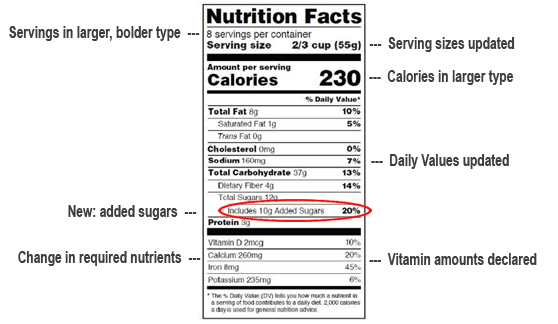
Why does the Nutrition Facts Panel look different on many food and beverage packages?
The U.S. Food and Drug Administration (FDA) has revised the Nutrition Facts Panel (NFP) for any food and beverage they regulate. This is an FDA initiative to assist consumers in making better informed food choices for themselves and their families. These changes to the Nutrition Fact Panel reflect new FDA labeling guidelines and, in most cases, does not reflect a change in product ingredients or formulations.
What is changing?
- The standard serving size for most beverages (e.g., waters, soft drinks, sports drinks, ready-to-drink teas, etc.) will change from 8 fluid ounces to 12 fluid ounces. The standard serving size for juice and juice beverages will remain 8 fluid ounces.
- The standard serving size for a few foods has changed. For example, the standard serving size for medium weight cereals is changing from 30 grams to 40 grams.
- The new NFP will use a “dual column” format, which shows nutrition information for the individual serving size and the entire container, on packages that contain 2 to 3 times the FDA recommended serving size. For example, the NFP on a 16 fluid ounce juice beverage will show nutrition information for a 8 fluid ounce serving and for the full 16 fluid ounces.
- The updated NFP format no longer lists “Calories from Fat” and more prominently highlights the amount of calories and servings per container. To accommodate the expanded NFP, there may be some additional visual changes to the product label.
- In the “Total Carbohydrates” section, the amount of Total Carbohydrates coming from “Added Sugars” (and a corresponding Daily Value) will now be broken out.
- The definition of Dietary Fiber as well as the Daily Value for Dietary Fiber have been revised.
- Vitamins and Minerals will be updated.
- The listing of potassium and vitamin D are now required, while the listing of vitamin A and vitamin C are now optional.
- The NFP will now carry Revised Daily Values for several nutrients, including potassium, calcium, vitamin D, sodium, and fiber.
What might be expected during this transition?
When companies begin to distribute products with the new NFP, there may be times when you see the same product on store shelves with the original NFP and the new NFP.
Learn More
As all food and beverage companies go through this transition, numerous questions will no doubt arise. The FDA has provided a number of resources.
